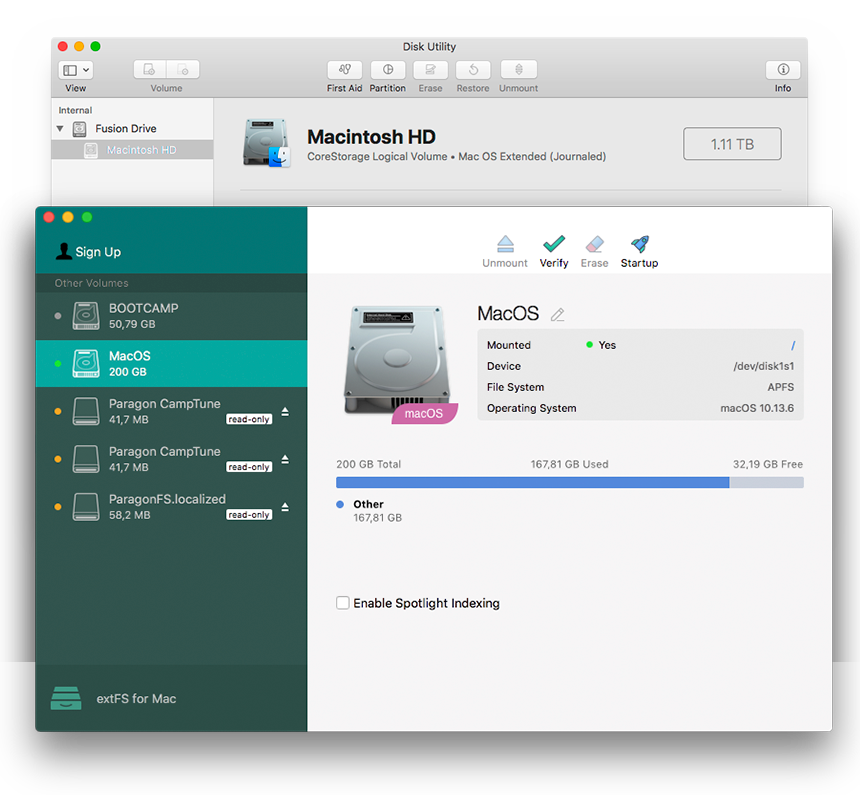
Like Ext4, XFS comes out of the box on quite a lot of Linux distributions. Not being able to disable journaling is something to be wary about if you’re worried about the SSD read/write limit. XFS is a journaling file-system, and it’s not possible to disable this feature.XFS has an SSD defragmentation feature, which is very useful, and will help keep your drive healthy.The performance advantages of XFS on an SSD mean that you’ll be able to transfer and access files and data much quicker than other file systems.By using XFS on your SSD, you can ensure that your files are safe. XFS is well-known for its ability to handle large amounts of data with ease.You’ll also get an SSD defragmentation feature.
#EXT4 READER FOR MAC OS INSTALL#
When you install a Linux OS to XFS on an SSD, you’ll get features comparable to Ext4, such as TRIM, and other optimizations.

So, if you have a lot of data, need to access it fast and plan to store it on an SSD, XFS is a great choice. It’s also well-known for its high-performance and speed. The XFS file system is loved in the Linux community for its ability to handle and manage significant portions of data reliably. If you don’t mind OpenSUSE and want to try out this file-system, install Leap! Alternatively, select “BtrFS” in the custom installation section when setting up your Linux PC. BtrFS has a copy-on-write feature that is arguably just as bad as filesystem journaling, and could (potentially) exhaust your SSD read/write limit.ītrFS has support in the Linux kernel, and many Linux distributions (like OpenSUSE) choose it as the default file system.BtrFS is highly unstable and has the potential to crash and corrupt your data if something goes wrong.BtrFS has an SSD defragmentation feature that allows users to clean up the data on their drive.The file system is new and under development so new features are added regularly.

BtrFS doesn’t have journaling on by default, so unlike Ext4, you won’t need to turn it off if you don’t want file system journals eating into your read/write rate.In addition, BtrFS also has a robust snapshot feature, which allows users to create (and roll-back) changes to the system instantly. Also, it has a more modern architecture, which makes it quite fast when accessing data.Īs you might expect, BtrFS supports the usual SSD features like TRIM, and other SSD optimizations (like defragmentation, etc.). Not having journaling allows it to save on write space (which is limited on SSDs). One reason that many people consider BtrFS for an SSD is that it doesn’t use a file system journal. BtrFSītrFS, by Oracle Corp, is a new kind of file-system that was created to mitigate problems, improve system performance, and make repair simple. Just set up your Linux distribution of choice like usual on your SSD, and you’re ready to go! 2. The best part about Ext4 is that you don’t need to enable a kernel module or install anything to use it.
#EXT4 READER FOR MAC OS HOW TO#
Ext4 has journaling on by default, and new users likely won’t know how to disable it to save read/writes on their SSDs.Ext4 is built on older technology, so it lacks modern file-system features found in systems like E2FS and BtrFS.Users can disable journaling to protect the limited read/write nature of their SSD.Along with the support for TRIM, Ext4 also includes a lot of other SSD optimizations (for performance).Ext4 is widely used on almost every Linux distribution today, and most Linux users are familiar with Ext4, so finding help when using it on your SSD isn’t very difficult.It’s reliable, trusted, and it offers up some excellent SSD-specific features like TRIM (necessary for the health of your drive,) and the ability to disable journaling which can vastly improve the longevity of a solid-state hard drive. The truth is, despite the debate around Ext4 in the Linux community, it’s the single best file-system to use, especially when you’re looking to use an SSD. It’s a vast improvement upon Ext3, and includes a lot of great features, including ones for Solid State Drives (SSDS).ĭespite how ubiquitous Ext4 is on Linux, if you look at forums and Reddit groups online, you might notice users disparaging Ext4, complaining about features it lacks and telling beginners to avoid it in favor of other boutique file systems.

Ext4Įxtended4 (aka Ext4) is the file system of choice for most distributions on Linux, and there’s a good reason for it. Setting up a new SSD on your Linux laptop or desktop? Unsure of what the best file system is to use? We can help! Here are the four best SSD-friendly file systems on Linux! 1.


 0 kommentar(er)
0 kommentar(er)
